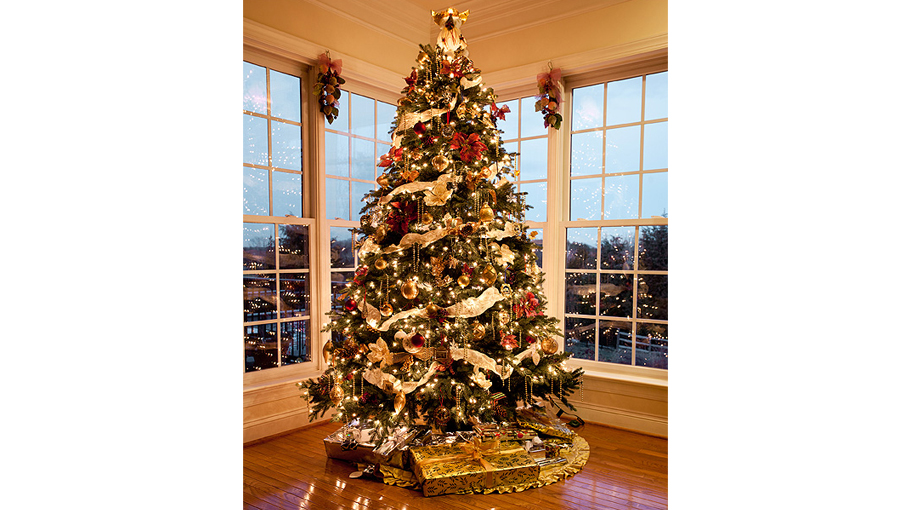Sacred Tree or Tree of Paradise? Nature and the Christmas Tree

The ancient Egyptians, Chinese, and Hebrews used evergreen wreaths, garlands, and trees to symbolise their respect for nature and their belief in eternal life. The pagan Europeans worshipped trees and had the custom of decorating their houses and barns with evergreens, or erecting a Yule tree during midwinter holidays. However, the modern Christmas tree can be shown to have roots in Christian traditions too.
The term ‘pagan’ originated in a contemptuous, disdainful, and disparaging attitude towards people who had a respect for nature, the source of their sustenance: “Paganism (from classical Latin pāgānus “rural”, “rustic”, later “civilian”) is a term first used in the fourth century by early Christians for people in the Roman Empire who practiced polytheism, or ethnic religions other than Judaism. Paganism has broadly connoted the “religion of the peasantry”.”
As people gradually converted to Christianity, December 25 became the date for celebrating Christmas. Christianity’s “most significant holidays were Epiphany on January 6, which commemorated the arrival of the Magi after Jesus’ birth, and Easter, which celebrated Jesus’ resurrection.” For the first three centuries of Christianity’s existence, “Jesus Christ’s birth wasn’t celebrated at all” and “the first official mention of December 25 as a holiday honouring Jesus’ birthday appears in an early Roman calendar from AD 336.” It is also believed that December 25 became the date for Christ’s birth “to coincide with existing pagan festivals honouring Saturn (the Roman god of agriculture) and Mithra (the Persian god of light). That way, it became easier to convince Rome’s pagan subjects to accept Christianity as the empire’s official religion.”
During the Middle Ages, the church used mystery plays to dramatize biblical stories for largely illiterate people to illustrate the stories of the Bible “from creation to damnation to redemption”. [1] Thus, we find evidence of a connection between the Christmas tree and the Tree of Life in the Paradise plays as well as pagan sacred trees.
In western Germany, the story of Adam and Eve was acted out using a prop of a paradise tree, a fir tree decorated with apples to represent the Garden of Eden:
The Germans set up a paradise tree in their homes on December 24, the religious feast day of Adam and Eve. They hung wafers on it (symbolizing the eucharistic host, the Christian sign of redemption); in a later tradition the wafers were replaced by cookies of various shapes. Candles, symbolic of Christ as the light of the world, were often added. In the same room was the “Christmas pyramid,” a triangular construction of wood that had shelves to hold Christmas figurines and was decorated with evergreens, candles, and a star. By the 16th century the Christmas pyramid and the paradise tree had merged, becoming the Christmas tree.”
The story of Adam and Eve begins with their disobedience, but the play cycle ends with the promise of the coming Saviour.
The medieval Church “declared December 24 the feast day of Adam and Eve.
“The first evidence of decorated trees associated with Christmas Day are trees in guildhalls decorated with sweets to be enjoyed by the apprentices and children. In Livonia (present-day Estonia and Latvia), in 1441, 1442, 1510, and 1514, the Brotherhood of Blackheads erected a tree for the holidays in their guild houses in Reval (now Tallinn)
and Riga.”
“Possibly the earliest existing picture of a Christmas tree being paraded through the streets with a bishop figure to represent St Nicholas, 1521 (Germanisches National Museum)”. See: The Medieval Christmas by Sophie Jackson (2005) p68)
Early records show “that fir trees decorated with apples were first known in Strasbourg in 1605. The first use of candles on such trees is recorded by a Silesian duchess in 1611.” Furthermore, the earliest known dated representation of a Christmas tree is 1576, seen on a keystone sculpture of a private home in Turckheim, Alsace (then part of the Holy Roman Empire of the German Nation, today France).
The paradise tree represented two important trees of the Garden of Eden: the Tree of the Knowledge of Good and Evil and the Tree of Life. It is likely that “because most other trees were barren and lifeless during December, the actors chose to hang the apples from an evergreen tree rather than from an apple tree.”
Actors portraying Adam and Eve are expelled from paradise (Eve: Ye must delve and I shall spin – our bodily sustenance for to win.) Performed by the Players of St Peter in the Church of St Clement Eastcheap, London, England in 2004 November.
Gary Greenberg has compared many stories of the bible with earlier Egyptian myths to try and understand where the ideas contained in the Old Testament originated. He explains:
“In the Garden of Eden God planted two trees, the Tree of Knowledge of Good and Evil, and The Tree of Life. Eating from the former gave one moral knowledge; eating from the latter conferred eternal life.
Caoimhghin Ó Croidheáin is an Irish artist who has exhibited widely around Ireland. His work consists of paintings based on cityscapes of Dublin, Irish history and geopolitical themes.
Source: CounterPunch




